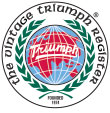Triumph Pressure Differential Warning Actuator
There’s a small, sometimes overlooked, piece of important equipment on Triumphs with dual (tandem) brake systems: the Pressure Differential Warning Actuator, also known as the PDWA.
Around the late ’60s, Triumph began using these simple devices to warn drivers of leaks in their braking system. I say “simple” because the actual mechanical portion is just that. The switch, however, and it’s electrical connection to the wiring harness took on slightly different variations through the years – consult the manual for your car.
The operation is straight forward and easy to understand. Although the early units had two internal pistons and two end caps, and later units had a single larger piston and one end opening, the operation is the same. When you apply the brake, pressure from the master cylinder’s front and rear lines flows by and exerts an equal force on either end of the piston(s) (sometimes referred to as the “shuttlecock”) located in the PDWA. If at any time, fluid leaks from either the front or rear system, the greater pressure from the end that’s not leaking will force the PDWA piston toward the side that can’t hold pressure. When that happens, the reduced dimension at the center of the piston is moved off-center, causing the actuating pin of the electrical switch to depress, triggering the dashboard warning light.
As with any brake component that uses rubber seals, they are subject to eventual failure. In the case of the PDWA, fault comes in the form of decaying “O” rings. When the O-rings fail to seal, brake fluid is allowed to enter the central switch chamber and eventually past the switch itself, creating an external brake fluid leak.
Although I couldn’t find a listing for a rebuild kit from the typical suppliers, Lucas Girling shows a drawing, and gives overhaul procedures in some of the generic instruction sheets that come bundled with their master cylinder overhaul kits. Lacking an official rebuild kit, and after experimenting with different compounds, I found the proper “O” rings by special order from a local hydraulics supplier.
Upon disassembly of my PDWA, I found the supposedly dry central switch chamber fouled with old brake fluid and contamination that had found its way past leaking “O” rings. My later style has one end cap, so the contents of the unit had to tapped out of that end. The far end “O” ring stuck in the bore and had to be carefully “hooked” out. Earlier units can be opened at both ends, making the internals a bit easier to push out. As with any brake component, carefully watch the order in which the parts come out. On the early two end cap units, there may be a tiny ball bearing and an “earth connection spring” that works with the switch assembly. Carefully examine the bore. It should be smooth and not pitted. If it’s pitted you’ve got two choices: replace with new (from about $90 – $190)), or have it resleeved by a place like White Post Restorations or Apple Hydraulics (about $60).
Barring a pitted bore, or really badly rusted components, the only renewable parts needed are two internal O-Rings and another “O” ring or copper crush washers fitted on the end plug(s). Early PDWAs, with the double pistons, used smaller square cut “O” rings. Unfortunately, these are hard to find in small quantities, and of the correct material. They can be replaced with the normal, round profile “O” ring of the same dimensions. That size should be something like 7/32″ ID x 11/32 OD (Uniform Dash size -009). Later units with single pistons have 3/8″ ID x 9/16″ OD (size -110) and a 5/8″ ID x 3/4″ OD (size -016) for the end cap seal. In either case, carefully measure the ID, OD, and profile of the old “O” rings just to be sure. I can only be sure of what I’ve disassembled!
Here’s the really important information. When you go to the local hydraulic supply counter, specify Ethylene Propylene (EP) for your “O” ring material. It’s the only compound that will stand up to a prolonged soak in DOT 3 or DOT 4 brake fluid. Anything else (at least at the time of this article) is doomed to early failure.
If you choose to replace your badly rusted early PDWA with a later unit, you may encounter a brake line thread problem. The threaded ports on the later, single piston, unit are different. Be prepared to replace one or two of the brake lines, or find yourself a brake line tool that will do an ISO or bubble flare. Eastwood carries the tool, but it’s about $70.
On reassembly, as with any brake component, work on a clean surface and use the brake fluid of your choice to lubricate all parts. Before replacing the switch (along with the ball bearing and spring on early units), check to make sure the reduced “waist” area of the piston is centralized below the switch hole. If the piston(s) are off center when you reinstall the PDWA, you’ll need to re-centralize the piston using the procedure in your shop manual.
